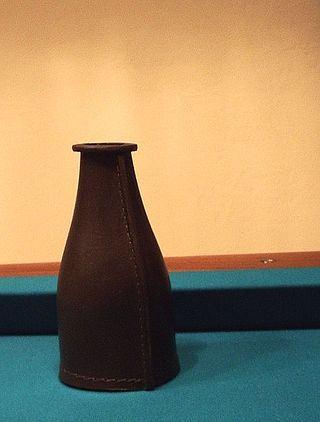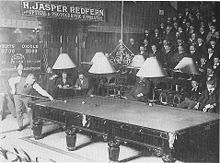
Cue sports are a wide variety of games of skill played with a cue, which is used to strike billiard balls and thereby cause them to move around a cloth-covered table bounded by elastic bumpers known as cushions. Cue sports are also collectively referred to as billiards, though this term has more specific connotations in some varieties of English.

Eight-ball is a discipline of pool played on a billiard table with six pockets, cue sticks, and sixteen billiard balls. The object balls include seven solid-colored balls numbered 1 through 7, seven striped balls numbered 9 through 15, and the black 8 ball. After the balls are scattered with a break shot, a player is assigned either the group of solid or striped balls once they have legally pocketed a ball from that group. The object of the game is to legally pocket the 8-ball in a "called" pocket, which can only be done after all of the balls from a player's assigned group have been cleared from the table.

Straight pool, which is also called 14.1 continuous and 14.1 rack, is a cue sport in which two competing players attempt to pocket as many object balls as possible without playing a foul. The game was the primary version of pool played in professional competition until it was superseded by faster-playing games like nine-ball and eight-ball in the 1980s.

A billiard ball is a small, hard ball used in cue sports, such as carom billiards, pool, and snooker. The number, type, diameter, color, and pattern of the balls differ depending upon the specific game being played. Various particular ball properties such as hardness, friction coefficient, and resilience are important to accuracy.

Carom billiards, also called French billiards and sometimes carambole billiards, is the overarching title of a family of cue sports generally played on cloth-covered, pocketless billiard tables. In its simplest form, the object of the game is to score points or "counts" by caroming one's own cue ball off both the opponent's cue ball and the object ball on a single shot. The invention as well as the exact date of origin of carom billiards is somewhat obscure but is thought to be traceable to 18th-century France.

Russian pyramid, also known as Russian billiards, is a form of billiards played on a large billiard table with narrow pockets. It is played across Russia and several former Soviet/Eastern Bloc countries. In the West, the game is known as pyramid billiards, or simply pyramid.

Straight rail, also called straight billiards, three-ball billiards, or the free game, is a discipline of carom billiards that is the most basic form of the game. The game is played on a pocketless unmarked billiard table, usually 10 by 5 feet in size, and three billiard balls, one, usually white, that serves as the cue ball for the first player, a second cue ball for the second player, and an object ball, usually red. The object of the game is to score points by striking the player's assigned cue ball with a cue stick so it makes contact with both the opponent's cue ball and the object ball in the same stroke, known as a carom. Games are played to a predetermined number of points.

A billiard table or billiards table is a bounded table on which cue sports are played. In the modern era, all billiards tables provide a flat surface usually made of quarried slate, that is covered with cloth, and surrounded by vulcanized rubber cushions, with the whole thing elevated above the floor. More specific terms are used for specific sports, such as snooker table and pool table, and different-sized billiard balls are used on these table types. An obsolete term is billiard board, used in the 16th and 17th centuries.

Pool is the name given to a series of cue sports played on a billiard table. The table has six pockets along the rails, into which balls are shot. Of the many different pool games, the most popular include: eight-ball, blackball, nine-ball, ten-ball, seven-ball, straight pool, one-pocket, and bank pool. Eight-ball is the most frequently played discipline of pool, and it is often thought of as synonymous with "pool".

Four-ball billiards or four-ball carom is a carom billiards game, played on a pocketless table with four billiard balls, usually two red and two white, one of the latter with a spot to distinguish it. Each player is assigned one of the white balls as a cue ball. A point is scored when a shooter's cue ball caroms on any two other balls in the same shot. Two points are scored when the shooter caroms on each of the three object balls in a single shot. A carom on only one ball results in no points, and ends the shooter's inning.

A rack is a piece of equipment that is used to place billiard balls in their starting positions at the beginning of a pocket billiards game. Rack may also be used as a verb to describe the act of setting billiard balls in their starting positions, or as a noun to describe a set of balls that are in their starting positions.
The following is a glossary of traditional English-language terms used in the three overarching cue sports disciplines: carom billiards referring to the various carom games played on a billiard table without pockets; pool, which denotes a host of games played on a table with six pockets; and snooker, played on a large pocket table, and which has a sport culture unto itself distinct from pool. There are also games such as English billiards that include aspects of multiple disciplines.
Cowboy pool is a hybrid pool game combining elements of English billiards through an intermediary game, with more standard pocket billiards characteristics. The game employs four balls, the cue ball and three others, numbered one, three, and five. A game of Cowboy pool is contested as a race to 101 points, with those points being awarded for a host of different shot types. Dating back to 1908, the game is a strictly amateur pastime.
Honolulu, also known as banks, kisses, and combinations or indirect, is a pocket billiards game. Players must pocket all shots in an indirect fashion to reach a set number of points. The game shares some similarities with other cue sports, played on tables and with balls used for pool, but differs with foul points being awarded for regular direct shots.

Five-pin billiards or simply five-pins or 5-pins, is today usually a carom billiards form of cue sport, though sometimes still played on a pocket table. In addition to the customary three balls of most carom games, it makes use of a set of five upright pins (skittles) arranged in a "+" pattern at the center of the table. The game is popular especially in Italy and Argentina, but also in some other parts of Latin America and Europe, with international, televised professional tournaments. It is sometimes referred to as Italian five-pins or Italian billiards, or as simply italiana. A variant of the game, goriziana or nine-pins, adds additional skittles to the formation. A related pocket game, with larger pins, is played in Scandinavia and is referred to in English as Danish pin billiards, with a Swedish variant that has some rules more similar to the Italian game.

Snooker is a cue sport that is played on a baize-covered snooker table with pockets in each of the four corners and in the middle of each of the long side cushions. It is played using a cue and snooker balls: one white cue ball, 15 red balls worth one point each, and six balls of different colours: yellow, green (3), brown (4), blue (5), pink (6), black (7). A player wins a frame of snooker by scoring more points than the opponent(s), using the cue ball to pot the red and coloured object balls. A player wins a match when they have achieved the best-of score from a pre-determined number of frames. The number of frames is always odd so as to prevent a tie or a draw.

Bottle pool, also known as bottle-billiards and bottle pocket billiards, is a hybrid billiards game combining aspects of both carom billiards and pocket billiards. Played on a standard pool table, the game uses just two object balls, a cue ball, and a 6+3⁄4 inches (170 mm) tall, narrow-necked bottle called a shake bottle or tally bottle, traditionally made from leather, that is placed on the table and used as a target for caroms. Those unfamiliar with the game sometimes mistakenly use its name as a synonym for the very different game of kelly pool. Bottle pool has been described as combining "elements of billiards, straight pool and chess under a set of rules that lavishly rewards strategic shot making and punishes mistakes with Sisyphean point reversals."

The English-originating version of eight-ball pool, also known as English pool, English eight-ball, blackball, or simply reds and yellows, is a pool game played with sixteen balls on a small pool table with six pockets. It originated in the United Kingdom and is played in the Commonwealth countries such as Australia and South Africa. In the UK and Ireland it is usually called simply "pool".
Carom billiards and pool are two types of cue sports or billiards-family games, which as a general class are played with a stick called a cue which is used to strike billiard balls, moving them around a cloth-covered billiard table bounded by rubber cushions attached to the confining rails of the table.
Slosh is a cue sport played on a snooker table. The game features seven balls, coloured white, yellow, green, brown, blue, pink and black, with points being scored for pocketing or playing caroms and cannons off object balls. The game is played to a score of 100 points, or a length of 30 minutes. First played in the early 1900s, not much is known about the game's origins.


















